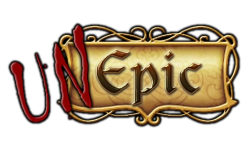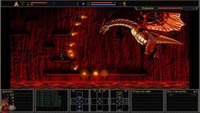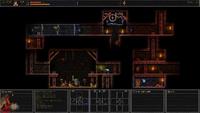|
|

|
PLATFORM
|
PS4
|
BATTLE SYSTEM
|

|
INTERACTION
|

|
ORIGINALITY
|

|
STORY
|

|
MUSIC & SOUND
|

|
VISUALS
|

|
CHALLENGE
|
Easy
|
COMPLETION TIME
|
Less than 20 Hours
|
|
OVERALL

|
+ Combat offers decent variety and options
+ Paced to keep things moving
- Sparse musical selections
- Final boss feels like a different game
|
Click here for scoring definitions
|
|
|
Going purely on its appearance, I expected my time with Unepic to be in line with its title. The screenshots I saw looked grainy, and not in a rose-colored-retro-lenses way. The narrative set-up also felt a bit uninspired. During a routine session of tabletop gaming with his buddies, Daniel gets up to take a leak. While in the bathroom, the light suddenly goes out. When he flicks on his lighter to regain his bearings, he finds he's been somehow transported into a magical castle filled with monsters. That's about the extent of it; a premise about as sophisticated as one would expect any seven-year-old to come up with. Reluctantly, I started out on my quest. To my surprise, by the end of that first gaming session, I had to admit that I was actually having fun, a trend which continued to see me through the twenty-or-so hour campaign. Turns out looks aren't everything.
A major part of Unepic's appeal lies in its well-crafted hack-and-slash gameplay, and it makes no bones about its Metroidvania-style inspirations. Players can keep the view zoomed in close to Daniel, or zoom out to show the entirety of the room. While exploring the castle, players will encounter a multitude of enemies, most of which are instantly familiar archetypes. Orcs, poison spiders, bats, and lumbering stone golems are commonplace. Though initially only sparsely armed and outfitted, players will soon discover that loot drops very frequently. Before long, Daniel has amassed a sizeable armory, which is helpful to stand up against the different types of enemies he encounters. Unepic can't be played by simply using a sword to cut through masses of foes; different enemy types have unique weaknesses. Swords are generally useful against biological enemies like beasts or unarmored foes, while blunt weapons like hammers and clubs are more useful against inorganic enemy types. There are also daggers, axes, spears with extra reach, bows, and more. Each weapon type is useful in a different situation, so keeping one of each on hand at all times is advisable.
The castle, Harnakon's Keep, is divided into distinct sections, like the dungeon, the laboratory, the mines, the library, and so on. Most enemies tend to be found in thematically appropriate areas. Giant serpents roam the sewer's canals, while mutated ants make the mines unsafe. Constantly switching between the appropriate weapons to deal with this assortment of baddies requires a good user interface. Daniel's inventory is pretty large, but fills up quickly with weapons, equipment, crafting ingredients, and a whole assortment of other things. Magic is split into six different schools, each requiring separate materials to cast spells. Potions, poisons, summonable pets, artifacts — all of these need to be handy at a moment's notice, as going into the inventory screen does not pause the game. Though there are a total of twelve shortcut slots available, most of the game is spent in a never-ending rearrangement of spells, items, and weapons.
 Bosses fill the screen with imposing size and heavy-hitting attacks.
Bosses fill the screen with imposing size and heavy-hitting attacks.
|
|
When it comes to actual battle, Unepic is enjoyably smooth. The combat system is simple, yet leaves enough room for plenty of variety. After some platforming by jumping from ledge to ledge, enemies such as a trio of skeletal guards catches sight of him and begins to close the gap. At this distance, it is more prudent to hurl fireballs at the approaching opponents, zapping their HP a bit. At the same time, Daniel's summoned pet is shooting bolts of light at the foes, temporarily stunning them in turn. Once the first one comes within striking distance, one or two well-placed hammer smashes will decimate him. The process is repeated for the remaining foes. In another room, a better approach may be to switch to a long-range polearm to work on the man-eating plants, keeping the player just out of their reach the entire time, while switching to Daniel's pet dragon will let him launch fireballs at the poisonous spiders crawling on the ceiling on the opposite side of the room. With the plants dispatched, switching to the long-range bow and arrow helps take out the distant foes for good.
Exploring each room in the castle is paramount; Daniel can light wall-mounted torches as he goes, and fully-lit rooms are updated on the map as a way to mark player progress. Each new zone of the castle becomes accessible by using a key obtained from the boss of the previous zone. These Guardians, seven very large bosses, are typically near the end of the zone, each requiring unique tactics to come out on top. Most zones also feature a room that houses a spirit, a being enshrined in a giant magical cube, who will task Daniel with obtaining special items in exchange for making a new school of magic available to him. Lesser quests can also be found all over the castle, typically with the objective being to collect a certain number of items or kill a specific enemy. These quests always reward the player with a useful item or piece of equipment, so they should not be passed up.
The jarringly simple graphical style was only part of the reason for my initial doubts about the game. The other factor was that the main character was unsympathetic at first. In fact, right off the bat Daniel comes off as juvenile and immature, rude even. Moments after entering Harnakon's Keep, Daniel is waylayed by a phantom, whom he dubs Zera. Zera attempts to take over Daniel's body to protect his master's castle, but the assault backfires, leaving Zera a prisoner in Daniel's body, unable to communicate with anyone other than Daniel. While initially an acrimonious relationship, it's their pairing that is a source of character development for both of them over the course of the game, as well as some genuine comic relief. Their repartee with each other, sprinkled into the game at predetermined locations, is impeccably voiced. Other characters are also fully voiced, though with varying results. Throughout, Unepic maintains a very tongue-in-cheek humor that often serves for laugh-out-loud moments. The game's music, on the other hand, is less of a triumph, with only a small handful of tracks repeating ad nauseum over the course of the game.
 A typical room in Harnakon's Keep.
A typical room in Harnakon's Keep.
|
|
While Unepic keeps its gameplay from getting stale, its rather low difficulty won't please those looking for a hefty challenge. The game generously provides a fast-travel hub to areas once they've been explored, as well as an artifact that's attained very early in the game that sends Daniel back to the only save room, located in a central portion of the Keep. From there, it's easy to head out to pretty much any zone using unlocked shortcuts, and should matters get hairy, a return to sanctuary is always just a second away, even during boss fights. Bosses represent the only real difficulty spike in the game, and may require multiple attempts to learn their patterns. Death should be expected here, but there is usually a short route back to them once the way has been opened for the first time. Playing on "Hard++" difficulty, the hardest setting, the campaign was more than manageable. An exception to this is the final boss encounter, which ends up introducing an entirely new gameplay concept by asking players to switch between two characters and achieve separate tasks and defeat waves of enemies while not letting either one die. To make things worse, this section runs on a pseudo-timer, as enemies encountered grow in toughness the longer it goes on.
One more fact bears mentioning. Though it takes place in a medieval fantasy universe, Unepic is rooted in the real world. As such, it is extremely self-aware. Expect pop culture references to anything from Star Wars to cell phones to neck-bearded nerd archetypes to pop up at any moment. There are even special weapons and items, like laser pistols and a summonable mini-version of the U.S.S. Enterprise that can be purchased using a special currency obtained by completing specific in-game challenges. It's all in good fun, poking fun at the conventions of modern role-playing games.
Unepic is not a perfect game by any means. Its tongue-in-cheek premise isn't everybody's cup of tea, and it doesn't particularly break any new ground. Instead what we get is a competent, if slightly linear, Metroidvania-style RPG that knows how to pace itself to keep the player engaged. After some early awkwardness, the characters and humor grew on me. It may not be the flashiest or grittiest, but it showed enough heart to keep me coming back and see it through to the end with no regrets. Don't be fooled by its name: Unepic is far from it.
Review Archives
|









